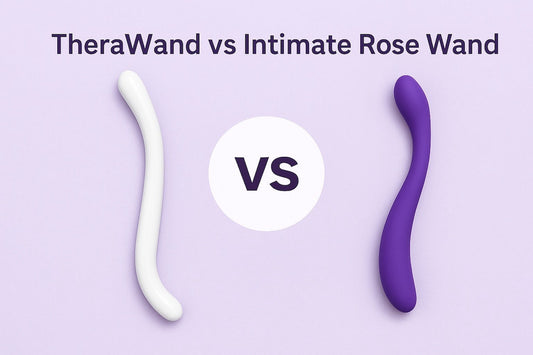Strong pelvic floor muscles are necessary to support pelvic organ function, however, strong pelvic floor muscles are not the same as tight pelvic floor muscles. When pelvic floor muscles are tight, blood flow and oxygen levels are restricted in the area, often resulting in deep pelvic pain, discomfort during penetration, pain during sex, constipation, and a burning sensation when urinating.
The good news is that learning to relax tight pelvic floor muscles will not only relieve these symptoms but will also help to strengthen the pelvic floor for a better quality of life, more enjoyable intercourse, and better orgasms.
In this article, we’ve discussed the causes and symptoms of tight pelvic floor muscles, in addition to some simple exercises, and why Pelvic Wands are the perfect tool to massage and relax deep trigger points in the pelvic floor.
What Are the Pelvic Floor Muscles?
The pelvic floor muscles and ligaments stretch like a hammock from the tailbone to the pubic bone, as well as side to side from one sitting bone to the other. The primary function of the pelvic floor muscles is to support pelvic organs like the bladder, bowel, vagina, and uterus.
When the pelvic floor muscles function correctly, they contract and relax when required.
Contracting the pelvic floor muscles, for example, lifts the pelvic organs and tightens the vaginal and anal openings to prevent incontinence. Relaxed pelvic floor muscles, on the other hand, allow for urination, as well as the passing of stools and gas. Before and during intercourse, the pelvic floor muscles also contract and relax spontaneously to heighten sexual arousal and deepen orgasms. And during pregnancy, the pelvic floor muscles contract to support the growing baby, however, they are required to relax during labor.
What Do Tight Pelvic Floor Muscles Feel Like?
Tight pelvic floor muscles, also known as pelvic floor dysfunction or hypertonic pelvic floor muscles, can feel like a constant sense of pressure, zinging, stabbing, and pain in the pelvis, lower abdomen, hips, and lower back. Even though the pain and pelvic discomfort associated with tight pelvic floor muscles are often described as persistent, many women find temporary relief when the body is relaxed in certain positions.
Additional symptoms can also include the following:
- Abdominal bloating & gas
- Constipation
- Burning sensation when urinating
- Difficulty emptying the bladder
- Urinating more frequently
- Urine leaks (incontinence)
- Pain during sex (dyspareunia)
What Causes Pelvic Tight Pelvic Floor Muscles?
The cause of tight pelvic floor muscles is difficult to pinpoint, in that, it varies from person to person and is often due to many factors. It is common, for example, for the pelvic muscles to tighten after childbirth and worsen as women age. Pelvic surgeries and injuries are also known to contribute to the tightening of pelvic muscles, as well as weight gain, poor posture, and several underlying conditions.
The main factors known to contribute to the tightening of the pelvic floor muscles include:
- Childbirth
- Pregnancy
- Getting older
- Holding urine or stools for too long
- Nerve damage
- Overuse of the pelvic muscles by pushing too hard when passing stools
- Pelvic surgery
- Pelvic trauma due to an accident
- Poor posture
- Previous sexual abuse
- Weight gain
Female conditions that are known to contribute to tight pelvic floor muscles include:
- Endometriosis
- Irritable bowel syndrome
- Interstitial cystitis
- Vaginismus
- Vestibulodynia
- Vulvodynia
How to Relax Pelvic Floor Muscles
Treatment to relax pelvic floor muscles and relieve pelvic floor tension typically involves physical therapy to lengthen and re-train the pelvic floor muscles. Learning to improve posture while sitting and standing also helps, as does losing weight for some women. Practicing particular yoga exercises at home and using pelvic wands to massage deep pelvic pain and release trigger points are also effective. If an underlying injury or sexual abuse is at the root of tight pelvic floor muscles, then counselling or sex therapy might also be recommended.
When seeking to relax tight pelvic floor muscles, however, it is first helpful to understand that the pelvic floor muscles are directly impacted by our breathing, and how a method called Diaphragmatic Breathing can help.
Diaphragmatic Breathing
Understanding that the diaphragm and pelvic floor muscles work in tandem can be useful to visualize the cyclical contraction and relaxation of the pelvic floor. As you inhale, for instance, your diaphragm drops and so do the pelvic floor muscles. Upon exhaling, the diaphragm relaxes into its dome shape to push the air out of the lungs, and at the same time, your pelvic floor muscles lift as well.
Also known as belly breathing, the goal of breathing diaphragmatically is to become more conscious of allowing the belly and diaphragm to expand on the inhale, rather than the chest, as is the case for most people with everyday breathing. This breathing practice not only increases awareness of how the pelvic floor muscles work correctly but can also help the parasympathetic nervous system to kick in and encourage tight muscles to relax.
How to Practice Diaphragmatic Breathing
Although women with tight pelvic floor muscles might not feel much in a physical sense by practicing diaphragmatic breathing, it is the act of imagining the pelvic floor muscles naturally contracting and relaxing with the inherent rhythm of breath that helps the muscles to relax.
To practice diaphragmatic breathing:
- Lay down to relax on your back with your knees bent or resting on a pillow, allowing your lower back to relax.
- Rest both hands on your lower rib cage and belly.
- Inhale for the count of 2 or 3 and focus on the feeling of your belly expanding and rising beneath your hands.
- As you slowly exhale for the count of 3 or 4 (making your inhale one count longer than your inhale) feel the belly lower beneath your hands
- Repeat 5-10 times daily.
Which Exercises Relax Tight Pelvic Floor Muscles?
Once patients have mastered a rhythmic flow of diaphragmatic breathing as explained above, pelvic health specialists recommend coupling it with the following exercises a few times per week to relax tight pelvic floor muscles. Holding each pose for 5-10 diaphragmatic breaths should help you to become more aware of the pelvic floor muscles and allow them to relax more and more with each exhale.
- Baby Pose
- Child’s Pose
- Sphinx Pose
- Yogi Squat
When Exercises Don’t Relax Tight Pelvic Floor Muscles
When exercises to relax tight pelvic floor muscles are not providing relief, help from a physical therapist specializing in pelvic rehabilitation is normally advised. Pelvic health physical therapists help patients to relax and re-train deep pelvic floor muscles that may have been overused, over-strained, or weakened. Additionally, physical therapists specializing in pelvic health can show patients how to use pelvic wands at home to locate and massage pelvic floor trigger points, as well as tender points.
What are Pelvic Floor Trigger Points & Tender Points?
Trigger points are described as tight bands or knots of muscle that are painful to touch. Trigger points can occur anywhere in the body and are normally caused by alignment imbalances, lack of exercise, injury, repeated straining or overuse of the muscles, poor posture, trauma, or prolonged muscle tension.
Tender points, on the other hand, are described as areas of soreness in either the muscles or the muscle-tendon junctions. When linked to pelvic pain or tight pelvic floor muscles, tender points are often caused by vaginal scar tissue after pelvic surgery, childbirth, or a hysterectomy. Tender points in the pelvis are also symptomatic of conditions like endometriosis, vaginismus, vestibulodynia, and vulvodynia.
How do Pelvic Wands Relax Tight Pelvic Floor Muscles?
Pelvic Wands help to locate, massage, and release tightness in hard-to-reach pelvic muscles, as well as painful trigger points and tender points in the pelvic floor. The release of deep pelvic trigger points not only helps to alleviate chronic pelvic pain but also reduces pelvic floor tightness & constipation and improves sexual pleasure.
Although there are several pelvic wands on the market, our favorite is the BPA-free, non-porous, medical-grade silicone pelvic wand from Intimate Rose. Considered smooth, comfortable to insert, and perfectly angled for effective relief, the unique ergonomic design of the Intimate Rose pelvic wand accommodates patients of all ages, genders, shapes, and sizes.
As the first and only FDA-registered pelvic wand made with medical-grade silicone, we regularly rely on the integrity of this product to assist the relaxation of tight pelvic floor muscles consistently and effectively. And you can too! When you choose Intimate Rose, you’ll also find plenty of videos, advice, detailed instructions, and support from their expert staff when needed.
Conclusion
In addition to causing pain and discomfort, tight pelvic floor muscles inevitably restrict the amount of blood and oxygen flowing to the pelvic region. This, in turn, can affect the support and functioning of many pelvic organs, including the bladder, bowel, and vagina, resulting in constipation, incontinence, and painful sex. To relax tight pelvic muscles diaphragmatic breathing and yoga stretches like child’s pose and baby pose often suffice. For those suffering from deep or chronic pelvic pain due to tight pelvic muscles, a consultation with a pelvic health specialist for more advice on using pelvic wands is recommended.
References
Cleveland Clinic – Hypertonic Pelvic Floor - https://my.clevelandclinic.org/health/diseases/22870-hypertonic-pelvic-floor
Healthline – Diapgragm Overview - https://www.healthline.com/human-body-maps/diaphragm
Intimate Rose – How to Treat Deep Pelvic Floor Pain - https://www.intimaterose.com/blogs/pelvic-pain/how-to-treat-deep-pelvic-floor-pain
Mayo Clinic – Chronic Pelvic Pain: Diagnosis & Treatment - https://www.mayoclinic.org/diseases-conditions/chronic-pelvic-pain/diagnosis-treatment/drc-20354371
Physiopedia – Trigger Points - https://www.physio-pedia.com/Trigger_Points



